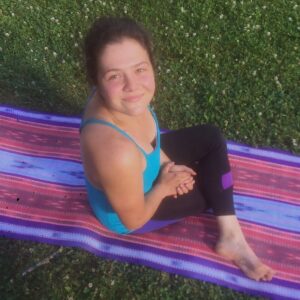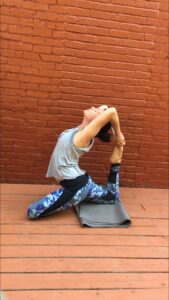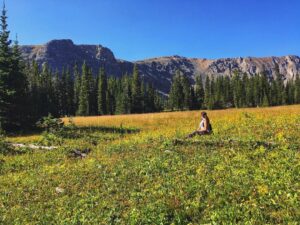 To celebrate Women’s History Month, we are posting a series of interviews with members of the Yoga District (YD) community who identify as feminists.
To celebrate Women’s History Month, we are posting a series of interviews with members of the Yoga District (YD) community who identify as feminists.
YD teacher Kelsey shares how intersectional feminism has shaped her yoga practice and her activism.
Tell us about yourself – where have you lived, what interests have you pursued in life, what or who makes you feel at peace?
I grew up in Cleveland, Ohio. To attend college at George Washington University, I moved to Washington, DC. I fell in love with the city and I started practicing at the I St Studio.
As an environmentalist at heart, I’ve worked on an organic farm, and now I am an environmental educator. I love connecting people to the natural world. I feel most like myself when I can incorporate the wisdom of plants into my teaching of yoga. During tree pose, I like to mention that trees communicate and even seemingly share resources through the mycorrhizal network (1). I encourage students to root down. Then imagine what they send out into the world and receive in return.
What does being a feminist mean to you?
I draw from the work of two women to help me frame my feminist action: Chimamanda Ngozi Adichie and Kimberlé Crenshaw. I appreciate Adichie’s definition of feminism from her book and TED Talk, “a person who believes in the social, political, and economic equality of the sexes” (2). I also recommend everyone listen to and read Kimberlé Crenshaw. She is the lawyer who coined the term “intersectionality” (3 and 4). Intersectionality is “the complex, cumulative way in which the effects of multiple forms of discrimination (such as racism, sexism, and classism) combine, overlap, or intersect especially in the experiences of marginalized individuals or groups.”
I feel it is so important that my feminism includes antiracism, environmentalism, disability justice, etc (5,6 and 7). To me being a feminist means to align my actions, words and thoughts with equity for all people in consideration of gender, race, and (dis)ability. As an able-bodied white woman, this entails a lot of reading and deconstructing.
I have to understand difference and discrimination before I can act towards this alignment. For example, in the past few years I have realized that many yoga studios cater to my experience with yoga. I have always felt welcomed in a yoga setting, and felt that the classes aligned with my ability level.
Do you feel your yoga practice is a feminist act? If so, how?
 Absolutely, yes! I am working with the idea that white supremacy and misogyny keeps us from connecting with our bodies. I recently read the wonderful book Love and Rage by Lama Rod Owens. He discusses the trauma that can appear in Black bodies from centuries of oppression. How dissociation from the physical body can be a coping strategy.
Absolutely, yes! I am working with the idea that white supremacy and misogyny keeps us from connecting with our bodies. I recently read the wonderful book Love and Rage by Lama Rod Owens. He discusses the trauma that can appear in Black bodies from centuries of oppression. How dissociation from the physical body can be a coping strategy.
Similarly, Liz Koch wrote an evocative article about the psoas and white supremacy’s form of dominating the body (8). In my yoga classes and Instagram meditations, I try to develop space for people to reconnect with their bodies and create the sense of allowing. Permitting the body to be just as it is. Enabling the body to move itself. I want us to honor, love, and stimulate our bodies through movement and breath. I say often, stillness and quiet is a radical act!
What do you love about being a yoga student?
I love the lifelong commitment I’ve made to myself and learning. There is always more to the pose, always more to learn about the philosophy! When I started practicing, I loved intense asana practices. As I’ve continued in my practice and become a teacher, I seek quieter practices such as Yin and Restorative. I’ve learned how to meditate, which makes me a better friend and family member. I still love to attend vinyasa classes. I laugh all the way through toppling out of a forearm stand. The continuing blossoming of the practice keeps me curious.
Who is a feminist who inspires you? Why?
There are so many writers and activists I could mention. Yet, my feminism and activism have evolved thanks to the wisdom and persistence of my friends. I am a better feminist because of my queer Muslim friend and my best friend, a Jewish woman. They enlighten my perspective. My clergy friends from working at a seminary ground my action in faith.
 Describe a time you felt included in a yoga class or a time you didn’t. Do you have advice to yoga teachers, staff and/or students on what they can do to make yoga classes more inclusive of feminist ideals and/or female-identifying participants?
Describe a time you felt included in a yoga class or a time you didn’t. Do you have advice to yoga teachers, staff and/or students on what they can do to make yoga classes more inclusive of feminist ideals and/or female-identifying participants?
The language we use in our cueing can have a huge impact. I learned through teaching people with visual impairments that cueing, “windshield-wiper your knees,” doesn’t land as well. Some folks may have context for the metaphors you use while others don’t. This thinking extends to including students in your class who have varying gender identities, students with a history of trauma, and so on.
I think a lot on the topic of femininity and masculinity as it shows up in the yoga practice. I consider more how attributes are yin and yang. Yin is feminine energy, moon, emptiness, solidity, stillness. Yang is masculine, sun, fluid. But consider the yin yang symbol itself, each term has a bit of its opposite. So too, do humans. We express masculine and feminine. We exist beyond traditional gender roles.
If you could practice yoga next to any feminist, who would it be?
Rosa Parks was a yoga practitioner (9)! I’d love to practice alongside her.
Sources
- Mycorrhizal associations (plants talk to each other), http://www.bbc.com/earth/story/20141111-plants-have-a-hidden-internet
- We should all be feminists | Chimamanda Ngozi Adichie, https://www.youtube.com/watch?v=hg3umXU_qWc
- Kimberlé Crenshaw, coined the term“intersectionality”, https://www.vox.com/the-highlight/2019/5/20/18542843/intersectionality-conservatism-law-race-gender-discrimination
- Kimberlé Crenshaw: The urgency of intersectionality | TED Talk, https://www.ted.com/talks/kimberle_crenshaw_the_urgency_of_intersectionality?language=en#t-381062
- Antiracist, https://nmaahc.si.edu/learn/talking-about-race/topics/being-antiracist
- History of Disability Justice, https://projectlets.org/disability-justice
- 10 Principles of Disability Justice, https://www.sinsinvalid.org/blog/10-principles-of-disability-justice
- White Bodies, Psoas, & Gesturing Power Over, https://coreawareness.com/white-bodies-psoas-gesturing-power-over/?fbclid=IwAR1zATrbpcv7ocY9ZRiaNA–2hRtq7UX7cjBE-tINe2UAybo_ONW8K2T7qo
- Rosa Practicing Yoga, https://www.loc.gov/exhibitions/rosa-parks-in-her-own-words/about-this-exhibition/detroit-1957-and-beyond/rosa-practicing-yoga/


